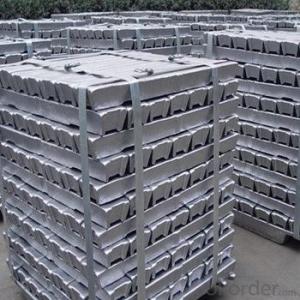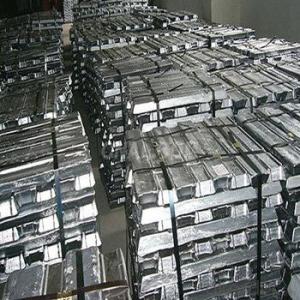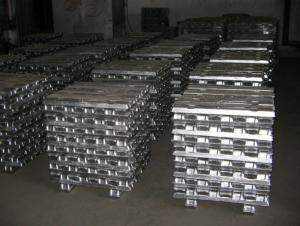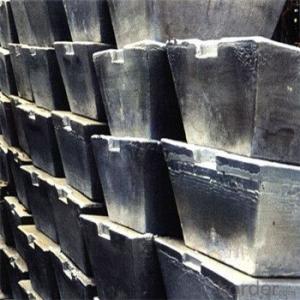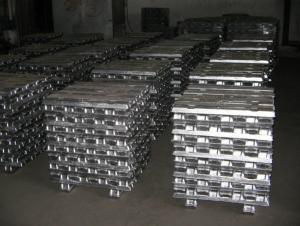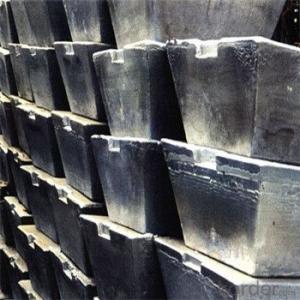Aluminum Pig/Ingot Provide From Factories
- Loading Port:
- China main port
- Payment Terms:
- TT OR LC
- Min Order Qty:
- 1000 m.t.
- Supply Capability:
- 100000 m.t./month
OKorder Service Pledge
OKorder Financial Service
You Might Also Like
Pure Aluminum Pig/Ingot Used for Industry
1.Structure of Aluminum Pig/Ingot
A material that has been cast into a shape in order to be transported and processed easier than in an unprocessed form. An ingot is typically rectangular in shape, which allows it to be stacked. Ingots are most commonly associated with metals, with ingots of gold held in the vaults of banks and brokerages being popular images.
Aluminum Ingot is with the AL as the main chemical composition.Aluminum Ingot is used for industry,such as automobile,pinning and weaving,electron broadly and so on. Aluminum Ingot has the following advantages: easy control and operation, fast melting.
2.Main Features of the Aluminum Pig/Ingot
•High Purity
•Easy control and operation
•High strength
•Fast melting
•Competitive price
•Best Service
3.Aluminum Pig/Ingot Images


4.Aluminum Pig/Ingot Specification
Grade | Chemical Composition % | |||||||||
Al≥ | impurities ≤ | |||||||||
Si | Fe | Cu | Ga | Mg | Zn | Mn | others | Sum | ||
Al99.9 | 99.90 | 0.50 | 0.07 | 0.005 | 0.02 | 0.01 | 0.025 | - | 0.010 | 0.10 |
Al99.85 | 99.85 | 0.80 | 0.12 | 0.005 | 0.03 | 0.02 | 0.030 | - | 0.015 | 0.15 |
Al99.7 | 99.70 | 0.10 | 0.20 | 0.010 | 0.03 | 0.02 | 0.030 | - | 0.030 | 0.30 |
Al99.6 | 99.60 | 0.16 | 0.25 | 0.010 | 0.03 | 0.03 | 0.030 | - | 0.030 | 0.40 |
Al99.5 | 99.50 | 0.22 | 0.30 | 0.020 | 0.03 | 0.05 | 0.050 | - | 0.030 | 0.50 |
Al99.00 | 99.00 | 0.42 | 0.50 | 0.020 | 0.03 | 0.05 | 0.050 | - | 0.050 | 1.00 |
5.FAQ of Aluminum Pig/Ingot
We have organized several common questions for our clients,may help you sincerely:
①How about your company?
A professional factory which foucs on producing the aluminum pig,can meet customers' requiement to the quality and grade.The quality also have been accepted by customer.Already got the good reputation among the customers.It have gotten lot of much experience.The facrtory has the professional Technical Worker and the advanced equipments for production.Beside,it has the profesional teams to operate the whole proess for exporting.OEM service is availble and welcome.The items have beedn exported around the world,and have been acceptable among the customers,and have gotten the good reputation already.No matter from the quality,price and service,can be guaranteed for the cusgtomers.High purity and diffent grade are available.
②How to guarantee the quality of the products?
We have established the international advanced quality management system,every link from raw material to final product we have strict quality test;We resolutely put an end to unqualified products flowing into the market. At the same time, we will provide necessary follow-up service assurance.
③How long can we receive the prod rking days, We will arrange the factory delivery as soon as possible. The pecific time of receiving is related to the state and position of customers.Commonly 7 to 10 working days can be served.
- Q:Can aluminum ingots be welded?
- Yes, aluminum ingots can be welded.
- Q:How are aluminum ingots used in the production of electrical connectors?
- Aluminum ingots are used in the production of electrical connectors as they provide a lightweight and durable material that is essential for efficient and reliable electrical connections. The ingots are melted down and cast into different connector shapes, ensuring the desired conductivity and strength. Aluminum's high electrical conductivity allows for efficient transmission of electricity, while its corrosion resistance ensures longevity of the connectors. These ingots are also easily malleable, allowing for precise shaping and customization of connectors to meet various electrical requirements.
- Q:How are impurities removed from aluminum ingots during production?
- Impurities are removed from aluminum ingots during production through a process called refining. The refining process typically involves two main steps: degassing and filtration. During degassing, the aluminum melt is subjected to high temperatures and low pressures. This helps in removing volatile impurities such as hydrogen, which can cause porosity and brittleness in the final product. The high temperature and low pressure conditions allow the impurities to escape as gas bubbles, which are then removed from the melt. Filtration is the next step in impurity removal. The aluminum melt is passed through a filtration system that contains ceramic filters or other porous materials. These filters are designed to trap solid impurities such as oxides, non-metallic particles, and other foreign materials. The filters have a specific pore size that allows only the molten aluminum to pass through while retaining the impurities. This filtration process helps in improving the quality of the aluminum by reducing the levels of non-metallic inclusions, which can negatively affect the mechanical properties of the final product. It also helps in controlling the grain structure and improving the overall homogeneity of the aluminum ingots. In addition to degassing and filtration, other refining techniques such as fluxing and electromagnetic stirring may also be employed depending on the specific requirements of the production process. Fluxing involves the addition of chemical compounds to the aluminum melt to facilitate the removal of impurities. Electromagnetic stirring uses electromagnetic fields to enhance the mixing and distribution of the melt, aiding in the removal of impurities. Overall, impurities are effectively removed from aluminum ingots during production through a combination of degassing, filtration, fluxing, and electromagnetic stirring processes. These refining techniques ensure that the final aluminum product meets the desired quality standards and exhibits optimal mechanical properties.
- Q:What are the quality standards for aluminum ingots?
- The quality standards for aluminum ingots typically include factors such as chemical composition, purity levels, physical properties like density and conductivity, as well as visual appearance and surface defects. These standards ensure that the aluminum ingots meet specific requirements for various industries and applications.
- Q:Can aluminum ingots be customized for specific applications?
- Certainly, specific applications can have customized aluminum ingots. Aluminum, a remarkably adaptable metal, can be effortlessly shaped to fulfill diverse needs. Typically, the customization procedure includes combining the aluminum with other elements to amplify qualities like strength, hardness, resistance to corrosion, and thermal conductivity. Furthermore, the ingots can undergo various heat treatment methods such as annealing, quenching, and tempering to further adjust their properties. Consequently, aluminum ingots that are precisely designed for particular applications can be manufactured, encompassing a wide range from automotive parts and aerospace components to construction materials and consumer products.
- Q:Who knows where needs aluminium ingot, aluminium powder, aluminium grain?
- Silver light metal. Ductility. Goods are often made in bars, sheets, foils, powders, ribbons, and filaments. A layer of oxide film that prevents metal corrosion is formed in moist air. Aluminum powder and aluminum foil heated in the air can burn violently and give a dazzling white flame. Soluble in dilute sulfuric acid, nitric acid, hydrochloric acid, sodium hydroxide and potassium hydroxide solution, insoluble in water.
- Q:What are the different joining techniques for aluminum ingots?
- There are several joining techniques commonly used for aluminum ingots, including welding, brazing, and adhesive bonding. Welding involves melting the base metal and adding a filler material to create a strong bond. Brazing uses a filler metal with a lower melting point than the base metal, which is heated and allowed to flow between the joined surfaces. Adhesive bonding involves using a specialized adhesive to bond the surfaces together, creating a strong and durable connection. Each technique has its advantages and is used depending on the specific application and requirements.
- Q:What are the energy requirements for producing aluminum ingots?
- The energy requirements for producing aluminum ingots can vary depending on several factors such as the type of production process, the source of energy used, and the efficiency of the production facility. However, generally, the production of aluminum ingots is an energy-intensive process. The primary method for producing aluminum ingots is through the smelting of aluminum oxide, or alumina, which is obtained from bauxite ore. The most common method used is the Hall-Héroult process, which involves the electrolysis of alumina dissolved in a molten cryolite electrolyte. In this process, a significant amount of energy is required to heat the alumina to its melting point of around 2,040 degrees Celsius and maintain it at this temperature. The energy is typically provided by large electric currents passed through the molten electrolyte, where the electrolysis takes place. Additionally, the production of aluminum ingots requires a substantial amount of electrical energy to break the chemical bonds in the alumina and separate the aluminum metal from the oxygen. The electrolysis process consumes a substantial amount of electricity, making aluminum production one of the largest consumers of electrical energy worldwide. The energy requirements for producing aluminum ingots can also be influenced by the source of electricity used. If renewable energy sources such as hydropower, wind power, or solar power are utilized, the environmental impact and carbon footprint of aluminum production can be significantly reduced. On the other hand, if the electricity is generated from non-renewable sources such as coal or natural gas, the energy requirements may be higher and contribute to higher greenhouse gas emissions. Efficiency improvements and technological advancements have been made in aluminum production processes over the years, leading to reductions in energy consumption. For example, the development of pre-baked anode technology has increased the energy efficiency of the Hall-Héroult process. Furthermore, recycling aluminum requires significantly less energy compared to primary production from bauxite ore, making it a more sustainable and energy-efficient option. In conclusion, the energy requirements for producing aluminum ingots are substantial due to the high temperatures required for the smelting process and the electricity needed for electrolysis. However, advancements in technology and the utilization of renewable energy sources can help reduce the energy consumption and environmental impact of aluminum production.
- Q:Could you tell me how to calculate the value of aluminum material? By weight or by length or by other means?
- By weight, but we should note that the market is now sub national standards, non-standard more than two kinds of weight profiles sold.
- Q:Can aluminum ingots be used in the production of jewelry?
- Yes, aluminum ingots can be used in the production of jewelry. However, aluminum is not a commonly used material for jewelry due to its low melting point and softness. It is often used in costume jewelry or as a base metal for plating.
1. Manufacturer Overview |
|
|---|---|
| Location | |
| Year Established | |
| Annual Output Value | |
| Main Markets | |
| Company Certifications | |
2. Manufacturer Certificates |
|
|---|---|
| a) Certification Name | |
| Range | |
| Reference | |
| Validity Period | |
3. Manufacturer Capability |
|
|---|---|
| a)Trade Capacity | |
| Nearest Port | |
| Export Percentage | |
| No.of Employees in Trade Department | |
| Language Spoken: | |
| b)Factory Information | |
| Factory Size: | |
| No. of Production Lines | |
| Contract Manufacturing | |
| Product Price Range | |
Send your message to us
Aluminum Pig/Ingot Provide From Factories
- Loading Port:
- China main port
- Payment Terms:
- TT OR LC
- Min Order Qty:
- 1000 m.t.
- Supply Capability:
- 100000 m.t./month
OKorder Service Pledge
OKorder Financial Service
Similar products
New products
Hot products







